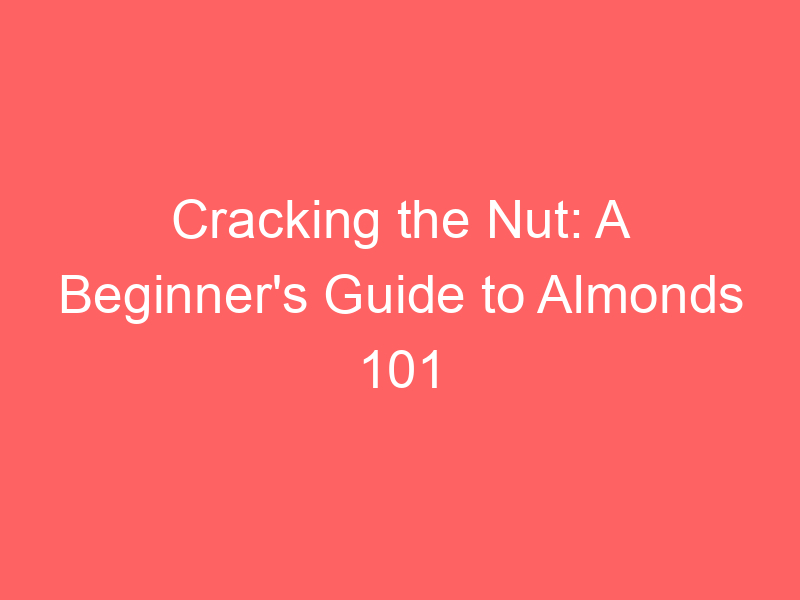Introduction to Almonds 101
Almonds are a popular and versatile nut, enjoyed by people all over the world. But what exactly are almonds, and why are they so important? Let’s dive into the world of almonds and discover why they are such a valuable addition to our diet.
- What are Almonds?
- Why Almonds are Important?
Almonds are the seeds of the almond tree, scientifically known as Prunus dulcis. They are native to the Middle East, but the United States, specifically California, is now the world’s largest producer. Almonds come in two types: sweet and bitter. The sweet variety is commonly eaten and used in cooking, while the bitter type is used to make almond oil, a popular ingredient in beauty products.
Almonds are not just tasty; they are also packed with nutrients and health benefits. They are a great source of protein, fiber, and healthy fats. They also contain important vitamins and minerals like vitamin E, magnesium, and potassium. Eating almonds can help improve heart health, support weight management, and even boost brain function. Plus, they are versatile and can be used in a variety of dishes, from salads to desserts, making them a great addition to any diet.
Now that we’ve covered the basics of what almonds are and why they’re important, let’s delve deeper into their nutritional profile, the differences between raw and roasted almonds, how to eat them, and some beginner-friendly almond recipes. Stay tuned!
Understanding Almond Nutrition
Almonds are not just delicious, they are also packed with a range of nutrients that are beneficial for our health. Let’s delve deeper into the nutritional profile of almonds.
Almonds Nutritional Profile
Almonds are a rich source of essential nutrients. They contain proteins, healthy fats, fiber, vitamins, and minerals that our body needs to function properly.
- Nutritional Value of Almonds
- Understanding the Nutritional Label
- Calories: This tells you how much energy you get from a serving of almonds.
- Protein: This is important for building and repairing tissues in your body.
- Fat: Almonds contain healthy fats, which are good for your heart.
- Fiber: This helps in digestion and keeps you feeling full for longer.
- Vitamins and Minerals: Almonds are rich in Vitamin E and Magnesium, both of which have numerous health benefits.
One ounce (approximately 28 grams) of almonds contains:
| Nutrient | Amount |
|---|---|
| Calories | 161 |
| Protein | 6 grams |
| Fat | 14 grams (9 of which are monounsaturated) |
| Fiber | 3.5 grams |
| Vitamin E | 37% of the RDI |
| Magnesium | 20% of the RDI |
RDI stands for Recommended Daily Intake, which is the amount of a nutrient that a person needs to consume each day.
Reading the nutritional label on a pack of almonds can help you understand the nutritional value of the nuts. Here’s what you need to know:
Understanding almond nutrition is the first step towards incorporating this superfood into your diet. In the next section, we will discuss the health benefits of almonds.
Health Benefits of Almonds
Almonds are not just tasty, they are also packed with a lot of health benefits. Let’s explore some of the key benefits of including almonds in your diet.
- Almonds for Heart Health
- Almonds for Brain Health
- Almonds for Skin Health
Almonds are a great source of monounsaturated fats and fiber, which are key for heart health. They also contain Vitamin E, which helps to lower bad cholesterol levels. A study found that people who consumed almonds five times a week had a 50% reduction in the risk of heart attack.
Almonds are often considered a ‘brain food’. They contain riboflavin and L-carnitine, nutrients that are known to boost brain activity and also reduce the risk of Alzheimer’s disease. A handful of almonds a day can lead to better brain health.
Almonds are packed with antioxidants and vitamins which are essential for your skin. They help to nourish your skin and make it smoother and softer. Almonds also have anti-aging properties that help reduce wrinkles, fine lines, and other signs of aging.
In conclusion, almonds are a powerhouse of nutrients and offer numerous health benefits. They are easy to incorporate into your diet and can be enjoyed in a variety of ways. So, why not grab a handful of almonds today and give your health a boost?
Raw Almonds vs Roasted Almonds
When it comes to almonds, there are two main types that you might find in your local grocery store: raw and roasted. But what’s the difference between the two? And more importantly, which one is better for you? Let’s dive in and find out.
- Comparison of Nutritional Values
- Which is Better and Why?
Both raw and roasted almonds are packed with nutrients, but they do have some differences. Let’s look at a comparison table:
| Raw Almonds | Roasted Almonds | |
|---|---|---|
| Calories | 161 | 167 |
| Protein | 6 grams | 6 grams |
| Fat | 14 grams | 15 grams |
| Fiber | 3.5 grams | 3 grams |
As you can see, the nutritional values are pretty similar. However, raw almonds have slightly less fat and more fiber.
So, which is better: raw or roasted almonds? The answer depends on your personal preference and dietary needs. If you’re looking to consume less fat and more fiber, raw almonds might be the better choice. However, some people prefer the taste and texture of roasted almonds.
One thing to keep in mind is that roasting can sometimes reduce the amount of certain nutrients in the almonds. So, if you’re eating almonds for their health benefits, raw might be the way to go. But remember, both types are still a great source of protein, healthy fats, and fiber.
In conclusion, whether you choose raw or roasted almonds, you’re making a healthy choice. Just be mindful of portion sizes, as almonds are high in calories. Happy snacking!
How to Eat Almonds
Almonds are a fantastic source of nutrients and can be a great addition to your daily diet. However, it’s important to know the best ways to consume them to maximize their health benefits. Here’s a simple guide to help you.
Guide to Eating Almonds
Almonds can be enjoyed in a variety of ways. They can be eaten raw, roasted, or even incorporated into your favorite recipes. Here are some key points to consider when eating almonds:
- Best Time to Eat Almonds
- How Many Almonds Should You Eat in a Day?
- Precautions and Warnings
Almonds can be eaten at any time of the day. However, many nutritionists recommend eating them in the morning to kickstart your metabolism. Almonds are rich in healthy fats and fiber, which can help you feel full and satisfied throughout the day.
While almonds are nutritious, moderation is key. A handful of almonds, approximately 23 almonds, is considered a serving. This amount provides about 160 calories and 14 grams of heart-healthy fats. Eating this amount daily can provide you with numerous health benefits without adding too many calories to your diet.
While almonds are generally safe to eat, they can cause allergic reactions in some people. If you have a tree nut allergy, you should avoid eating almonds. Additionally, eating too many almonds can lead to weight gain due to their high calorie and fat content. Always remember to eat almonds in moderation.
In conclusion, almonds are a versatile and nutritious food that can be enjoyed in many ways. By following these guidelines, you can incorporate almonds into your diet in a healthy and beneficial way.
Almond Recipes for Beginners
Now that we’ve learned about the nutritional value of almonds and the different ways to eat them, let’s dive into some simple and delicious almond recipes that even beginners can master. These recipes will help you incorporate almonds into your diet in a variety of ways.
-
Almond Milk Recipe
Almond milk is a great dairy-free alternative and it’s surprisingly easy to make at home. Here’s a simple recipe:
- Soak 1 cup of raw almonds in water overnight.
- Drain the almonds and blend them with 4 cups of water.
- Strain the mixture using a cheesecloth to get the almond milk.
- You can sweeten it with a bit of honey or vanilla extract if you like.
This homemade almond milk can be stored in the fridge for up to five days.
-
Almond Butter Recipe
Almond butter is a nutritious and tasty spread that can be used in a variety of dishes. Here’s how you can make it at home:
- Roast 2 cups of almonds in the oven at 350 degrees for 10 minutes.
- Let the almonds cool down and then blend them in a food processor until smooth.
- Add a pinch of salt and your almond butter is ready!
Store your homemade almond butter in an airtight container in the fridge.
-
Almond Flour Recipe
Almond flour is a gluten-free alternative to wheat flour that’s used in a variety of baking recipes. Here’s how you can make it at home:
- Blanch 2 cups of almonds in boiling water for a minute and then peel off the skins.
- Let the almonds dry completely and then blend them in a food processor until they reach a flour-like consistency.
Store your homemade almond flour in an airtight container in a cool, dry place.
These are just a few ways to start incorporating almonds into your diet. Remember, the key to a healthy diet is variety, so feel free to experiment with these recipes and make them your own!
Conclusion: The Beginner’s Guide to Almonds
As we conclude our journey through the world of almonds, it’s clear that these small but mighty nuts are more than just a tasty snack. They’re packed with nutrition, versatile in the kitchen, and can be enjoyed in many forms – raw or roasted. Let’s recap what we’ve learned.
-
Key Takeaways
- Almonds are Nutritious: They are a rich source of essential nutrients, including protein, healthy fats, fiber, vitamins, and minerals.
- Raw vs Roasted: Both raw and roasted almonds have their unique benefits. Raw almonds retain all their natural nutrients, while roasted almonds offer a different flavor profile and texture.
- Eating Almonds: Almonds can be enjoyed in many ways – as a snack, in salads, as almond milk, or even in baking.
- Almond Recipes: There are countless recipes that include almonds, from simple snacks to more complex dishes. Experimenting with these can be a fun and healthy culinary adventure.
-
Further Reading and Resources
For those who want to delve deeper into the world of almonds, there are many books and online resources available. Some recommended titles include “The Almond Cookbook” by Barbara Bryant and “The Almond Milk Cookbook” by Alan Roettinger. These books offer a wealth of information on the nutritional benefits of almonds, as well as a plethora of recipes to try.
In conclusion, almonds are a versatile, nutritious, and delicious addition to any diet. Whether you’re a beginner or a seasoned almond enthusiast, there’s always more to learn and explore. So, keep experimenting, keep learning, and most importantly, keep enjoying almonds!






